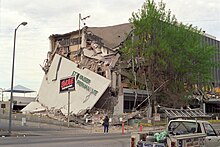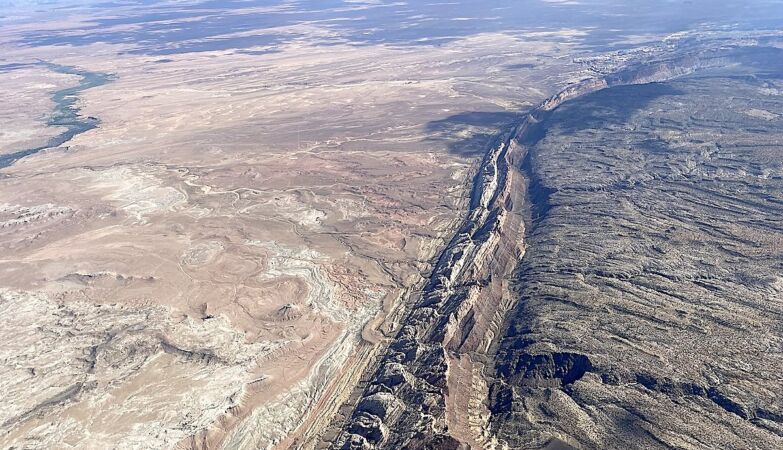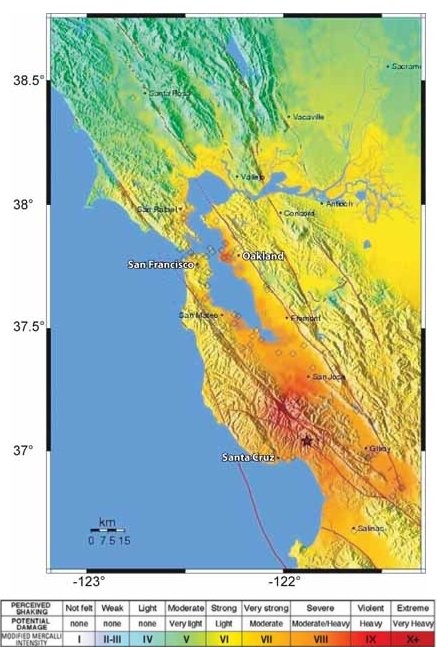sexta-feira, outubro 17, 2025
O sismo de Loma Prieta foi há trinta e seis anos...
Postado por
Fernando Martins
às
00:36
0
bocas
![]()
Marcadores: Califórnia, falha de Santo André, Loma Prieta, São Francisco, sismo, sismologia, USA
sexta-feira, abril 04, 2025
O Sismo de Baja California foi há quinze anos
| Magnitude | 7.2 MW |
| Data | 4 de abril de 2010 |
| Zonas atingidas | |
| Vítimas | 2 mortos, mais de 200 feridos |
O Sismo de Baja California de 2010 ocorreu no estado mexicano de Baja California a 4 de abril de 2010, às 22.40 (UTC). O hipocentro do sismo situou-se a 10 quilómetros de profundidade e o epicentro localizou-se nas coordenadas 32.1° N, 115.3° W, a 60 quilómetros a sudeste da capital do estado, Mexicali, perto da fronteira com os Estados Unidos da América, numa zona onde vivem 900 mil habitantes, e a cerca de 175 quilómetros a leste-sudeste de Tijuana, onde o sismo foi sentido por cerca de 40 segundos, fazendo tremer alguns prédios e provocando o corte de energia elétrica nalgumas áreas da cidade.
Inicialmente o Serviço Geológico dos Estados Unidos indicou a magnitude do sismo como sendo de 6,9, mas posteriormente modificou para 7,2 graus 
Este sismo foi o mais forte registado na região desde 1992, quando outro abalo atingiu uma magnitude de 7,3 na escala de Richter.
Postado por
Fernando Martins
às
00:15
0
bocas
![]()
Marcadores: falha de Santo André, Laguna Salada Fault, México, sismo, sismo de Baja California de 2010, USA
sexta-feira, janeiro 17, 2025
O sismo de Northridge foi há trinta e um anos...

Damage and fatalities
Postado por
Fernando Martins
às
00:31
0
bocas
![]()
Marcadores: Califórnia, falha de Santo André, sismo, sismo de Northridge, sismologia
quinta-feira, outubro 17, 2024
O sismo de Loma Prieta foi há trinta e cinco anos...
Postado por
Fernando Martins
às
00:35
0
bocas
![]()
Marcadores: Califórnia, falha de Santo André, Loma Prieta, São Francisco, sismo, sismologia, USA
quinta-feira, abril 18, 2024
Há uma secção da falha de Santo André pronta a fazer estragos...
Sismólogos suspeitam que terramoto na falha de San Andreas está iminente

Falha de San Andreas, na Califórnia
Um novo estudo conduzido por sismólogos italianos e norte-americanos sugere que uma parte da Falha de San Andreas, em Parkfield, na Califórnia, não está a dar sinais que sugiram que um terramoto vai ocorrer em breve - mas afirmam que há fatores que sugerem o contrário.
Apesar de haver “parâmetros atenuantes invulgares”, os sismólogos Luca Malagnini, do Istituto Nazionale di Geofisica e Vulcanologia, em Itália, e Robert Nadeau e Tom Parsons, da Universidade da Califórnia, suspeitam que um terramoto na Falha de San Andreas pode estar iminente.
As suspeitas dos três sismólogos são apresentadas num artigo científico recentemente publicado na revista Frontiers in Earth Science.
A parte da Falha de San Andreas situada perto de Parkfield, na Califórnia, oferece aos cientistas que estudam os terramotos uma oportunidade única: a norte de Parkfield, duas grandes placas deslocam-se uma contra a outra a um ritmo constante. A sul de Parkfield, por outro lado, a falha está bloqueada.
Esta circunstância, explica o Phys, leva a que os terramotos ocorram com um padrão: aproximadamente a cada 22 anos, e permite aos investigadores recolher dados sísmicos antes, durante e depois de um terramoto.
Esses terramotos também têm quase sempre a mesma magnitude, cerca de 6 na Escala de Richter, ou ligeiramente superior.
O último terramoto que ocorreu no local foi em 2004, o que sugere que deverá ocorrer um terramoto nos próximos dois anos. Mas há um problema – a atividade sísmica relacionada com a falha não indica quaisquer sinais de um terramoto.
Normalmente, observam os autores do estudo, as ondas de baixa frequência atenuam-se antes de um terramoto, enquanto as ondas de alta frequência aumentam. Mas, neste momento, não há sinais de nenhum destes fenómenos.
Os investigadores salientam que o último terramoto que aconteceu na área ocorreu com um atraso com cerca de 14 anos de atraso.
Este atraso, no entanto, deveu-se essencialmente ao facto de outros sismos terem ocorrido suficientemente perto para aliviar a pressão sobre Parkfield - o que não é o caso desta vez.
Os três sismólogos acreditam que a pressão tectónica em zonas próximas da falha poder provocar brevemente um terramoto, mas com um epicentro algo deslocado.
Os investigadores não têm porém confiança absoluta nas suas leituras, pelo que optaram por não apresentar previsões formais. Em vez disso, sugerem que, como é sempre o caso com os terramotos, esperemos para ver o que acontece.
Felizmente, “esperar para ver o que acontece” não é neste caso um grande problema. Ao contrário da densamente povoada região de São Francisco, a cidade inquieta que está sempre à espera do “Big One”, quase ninguém vive em Parkfield.
in ZAP
Postado por
Fernando Martins
às
11:38
0
bocas
![]()
Marcadores: Califórnia, falha de Santo André, sismo, sismologia
quinta-feira, abril 04, 2024
O Sismo de Baja California foi há catorze anos
| Magnitude | 7.2 MW |
| Data | 4 de abril de 2010 |
| Zonas atingidas | |
| Vítimas | 2 mortos, mais de 200 feridos |
O Sismo de Baja California de 2010 ocorreu no estado mexicano de Baja California a 4 de abril de 2010, às 22.40 (UTC). O hipocentro do sismo situou-se a 10 quilómetros de profundidade e o epicentro localizou-se nas coordenadas 32.1° N, 115.3° W, a 60 quilómetros a sudeste da capital do estado, Mexicali, perto da fronteira com os Estados Unidos da América, numa zona onde vivem 900 mil habitantes, e a cerca de 175 quilómetros a leste-sudeste de Tijuana, onde o sismo foi sentido por cerca de 40 segundos, fazendo tremer alguns prédios e provocando o corte de energia elétrica nalgumas áreas da cidade.
Inicialmente o Serviço Geológico dos Estados Unidos indicou a magnitude do sismo como sendo de 6,9, mas posteriormente modificou para 7,2 graus 
Este sismo foi o mais forte registado na região desde 1992, quando outro abalo atingiu uma magnitude de 7,3 na escala de Richter.
Postado por
Fernando Martins
às
00:14
0
bocas
![]()
Marcadores: falha de Santo André, Laguna Salada Fault, México, sismo, sismo de Baja California de 2010, USA
quarta-feira, janeiro 17, 2024
O sismo de Northridge foi há trinta anos...

Damage and fatalities
Postado por
Fernando Martins
às
00:30
0
bocas
![]()
Marcadores: Califórnia, falha de Santo André, sismo, sismo de Northridge, sismologia, Us
terça-feira, outubro 17, 2023
O sismo de Loma Prieta foi há trinta e quatro anos...
Postado por
Fernando Martins
às
00:35
0
bocas
![]()
Marcadores: Califórnia, falha de Santo André, Loma Prieta, São Francisco, sismo, sismologia, USA
terça-feira, abril 04, 2023
O Sismo de Baja California foi há treze anos
| Magnitude | 7.2 MW |
| Data | 4 de abril de 2010 |
| Zonas atingidas | |
| Vítimas | 2 mortos, mais de 200 feridos |
O Sismo de Baja California de 2010 ocorreu no estado mexicano de Baja California em 4 de abril de 2010, às 22h40min (UTC). O hipocentro do sismo situou-se a 10 quilómetros de profundidade e o epicentro localizou-se nas coordenadas 32.1° N, 115.3° W, a 60 quilómetros a sudeste da capital do estado, Mexicali, perto da fronteira com os Estados Unidos da América, numa zona onde vivem 900 mil habitantes, e a cerca de 175 quilómetros a leste-sudeste de Tijuana, onde o sismo foi sentido por cerca de 40 segundos, fazendo tremer alguns prédios e provocando o corte de energia elétrica nalgumas áreas da cidade.
Inicialmente o Serviço Geológico dos Estados Unidos indicou a magnitude do sismo como sendo de 6,9, mas posteriormente modificou para 7,2 graus 
Este sismo foi o mais forte registado na região desde 1992, quando outro abalo atingiu uma magnitude de 7,3 na escala de Richter.
Postado por
Fernando Martins
às
13:00
0
bocas
![]()
Marcadores: falha de Santo André, Laguna Salada Fault, México, sismo, sismo de Baja California de 2010, USA
terça-feira, janeiro 17, 2023
O sismo de Northridge foi há 29 anos...
Postado por
Fernando Martins
às
00:29
0
bocas
![]()
Marcadores: Califórnia, falha de Santo André, sismo, sismo de Northridge, sismologia, USA
segunda-feira, outubro 17, 2022
O sismo de Loma Prieta foi há trinta e três anos...
Postado por
Fernando Martins
às
00:33
0
bocas
![]()
Marcadores: Califórnia, falha de Santo André, Loma Prieta, São Francisco, sismo, sismologia, USA
segunda-feira, abril 04, 2022
Há doze anos ocorreu o Sismo de Baja California
| Magnitude | 7.2 MW |
| Data | 4 de abril de 2010 |
| Zonas atingidas | |
| Vítimas | 2 mortos, mais de 200 feridos |
O Sismo de Baja California de 2010 ocorreu no estado mexicano de Baja California em 4 de abril de 2010, às 22h40min (UTC). O hipocentro do sismo situou-se a 10 quilómetros de profundidade e o epicentro localizou-se nas coordenadas 32.1° N, 115.3° W, a 60 quilómetros a sudeste da capital do estado, Mexicali, perto da fronteira com os Estados Unidos da América, numa zona onde vivem 900 mil habitantes, e a cerca de 175 quilómetros a leste-sudeste de Tijuana, onde o sismo foi sentido por cerca de 40 segundos, fazendo tremer alguns prédios e provocando o corte de energia elétrica nalgumas áreas da cidade.
Inicialmente o Serviço Geológico dos Estados Unidos indicou a magnitude do sismo como sendo de 6,9, mas posteriormente modificou para 7,2 graus 
Este sismo foi o mais forte registado na região desde 1992, quando outro abalo atingiu uma magnitude de 7,3 na escala de Richter.
Postado por
Fernando Martins
às
00:12
0
bocas
![]()
Marcadores: falha de Santo André, Laguna Salada Fault, México, sismo, sismo de Baja California de 2010, USA
segunda-feira, janeiro 17, 2022
O sismo de Northridge foi há 28 anos
Postado por
Fernando Martins
às
00:28
0
bocas
![]()
Marcadores: Califórnia, falha de Santo André, sismo, sismo de Northridge, sismologia, USA










